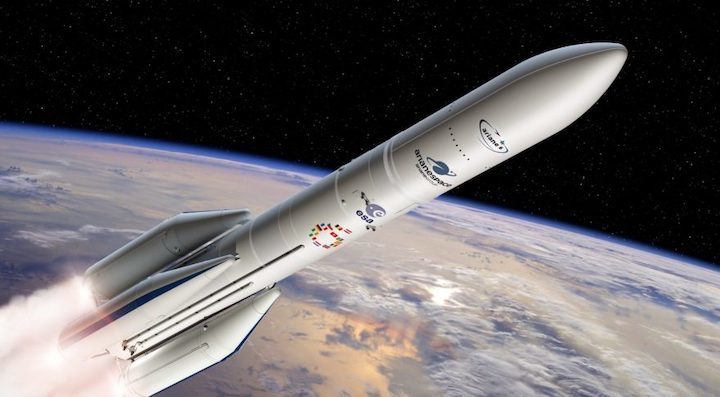20.04.2019

An ESA council agreement reached April 17 gave ArianeGroup the confidence to start full launcher production for Ariane 6. Credit: ESA
The European Space Agency’s 22 member states agreed April 17 to a workaround to get Ariane 6 production in full swing despite a dearth of public sector launch contracts.
ArianeGroup had reached an impasse with ESA, which is paying the Franco-German company to design and build the Ariane 6 rocket, after the number of expected government missions fell short of what was agreed upon early on in the program.
ESA and ArianeGroup plan 14 missions with Ariane 6 during the transition from the Ariane 5, slated to take place from 2020 to 2023. Seven of those missions are expected to be public sector customers, but as the inaugural flight of Ariane 6 approaches in July 2020, European government customers have ordered only three launches.
As a result, ArianeGroup had not started full-scale production of Ariane 6 beyond the first rocket and some long-lead items like engines, missing a 2018 goal to have factories humming.
In an April 18 interview, Daniel Neuenschwander, ESA’s director of space transportation, said the agency’s member states agreed unanimously during a council session yesterday on the “founding conditions and the way we start the exploitation of Ariane 6.”
“We came up with a certain point of what type of missions we are going to need to launch on Ariane 6 … [now] industry has to make sure that we have a number of Ariane 6s available to us for our European institutional use,” he said.
André-Hubert Roussel, ArianeGroup’s CEO, told SpaceNews ESA’s decision assuaged the company’s concerns about not having enough demand to commence with full-scale production.
“The resolution that they adopted provides us not the orders, but the guaranteed equivalent that we will be covered if these orders will not materialize in a reasonable time,” Roussel said of the seven missions.
The subsidy question
Neuenschwander declined to say if ESA would authorize subsidies for the Ariane 6 program. He said there are a “number of measures” that ESA’s director general will propose during the agency’s ministerial conference this November in Seville, Spain. The ministerial is where ESA seeks funding from its member states.
“We have an overall package for space transportation that is much broader, and there will be some dedicated measure in this overall package, but I’d say let’s see in November where we are on this,” he said regarding subsidies.
One mission ESA will propose additional financial support for is the first launch of the larger Ariane 6 version: the Ariane 64, which has four strap-on boosters. Arianespace signed megaconstellation company OneWeb as the customer for the 2020 maiden flight of Ariane 6, which will be the lighter 62 version with two strap-on boosters. The company has yet to secure a customer for the first launch of the heavier variant.
“If seven launch service contracts are not signed by the ministerial at the end of November, then the ESA DG [Director General Jan Woerner] will propose for decision to member states to complement the revenues needed for the first Ariane 64,” Neuenschwander said.
Neuenschwander said ESA wants to see Ariane 64 fly with a commercial customer before assigning agency spacecraft to the rocket. ESA has a ceiling for how much funding it will give to support the first Ariane 64 mission, he said, but declined to give specifics.
Ramping production
With ESA’s new backing, Roussel said ArianeGroup should be able to have its next launcher built just in time for Arianespace’s first government customer: the European Commission.
Roussel said Ariane 6 rockets are projected to take around two years to build, meaning ESA’s new resolutions concluded just in time to keep the launcher on track.
“If you make a very simple calculation, starting from April 2019 means a second flight in April 2021,” he said. “This is exactly the time frame where the first [government] customer, the European Commission, wants to launch Galileo satellites. It was super important for us to be able to start to produce, otherwise we would have had to tell European Commission that we would not be on time.”
Roussel said he is confident other government contracts will materialize to eventually fill the four expected public-sector missions. The German government has some Earth observation satellites that will need launch services, he said, along with future ESA and European Commission satellites.
“It is just a question of negotiation and contractualization,” he said.
Roussel said there are several prospects for the first commercial launch of the Ariane 64, which is planned for 2021. Neuenschwander said ESA wants to have Ariane 64 as an option for its Jupiter Icy Moons Explorer, or JUICE, mission, but would only consider launching the science mission on the new rocket after seeing a commercial launch. JUICE is currently scheduled to launch in 2022 on an Ariane 5.
Quelle: SN
